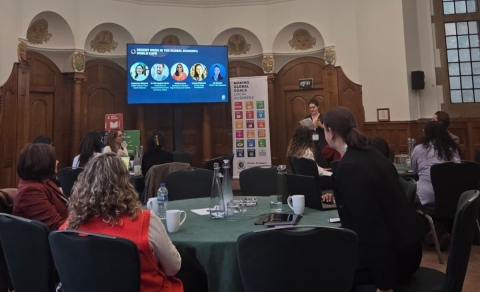An additional US$120 billion in savings could also be generated by “refinancing” middle-income countries’ bond debt to official creditor rates.
Debt savings of up to US$148 billion could be unlocked by the UN SDG stimulus plan, says UN Development Programme
22 FEBRUARY, 2023

UNDP policy brief identifies 52 low and middle-income developing economies either in debt distress or at high risk of debt distress, accounting for more than 40 percent of the world’s poorest people.
Paris - Developing economies could secure hundreds of billions of dollars in savings if the world commits to restructuring their existing debt and expanding access to future affordable finance, according to a new policy brief published today by the United Nations Development Programme (UNDP).
The brief – ‘Building Blocks Out of The Crisis’ – identifies 52 low and middle-income developing economies either in debt distress or at high risk of debt distress, accounting for more than 40 percent of the world’s poorest people. It shows how a 30 percent haircut on their public external debt stock in 2021 could help save up to $148 billion in debt service payments over eight years.
Ahead of the G20 Finance Ministers and Central Bank Governors Meeting in Bangalore this week, world leaders have been urged to take action to help cushion developing countries from the impacts of today's overlapping crises while also ensuring that financial resources are aligned to support just, inclusive and equitable transitions for all countries.
“The building blocks to transform the global financial system are already being discussed at the G20 --- multilateral development bank reform, debt restructuring and injections of liquidity – but with the fracture between developed and developing countries escalating rapidly we need to move from words to action,” said Achim Steiner, Administrator at UNDP.
Today, 25 developing economy governments have external debt service payments higher than 20 percent of total revenue – the highest number of countries in more than 20 years. Coupled with rising debt burdens this crowds out space for spending on essential services, including measures to adapt and respond to the climate crisis.
“The countries most burdened by debt and lack of access to financing are also being battered by multiple other crises – they are among the most affected by the economic impact of COVID19, poverty and the accelerating climate emergency. The time has come to address the deepening chasm between rich and poor countries, to change the multilateral landscape, and to create a debt architecture that is fit for purpose in our complex, interconnected and post-COVID world,” Steiner continued.
The policy brief outlines the urgent policy steps needed to reverse the current debt crisis and shows the potentially transformative impact of dealing with debt and expanding access to lower cost and long-term maturity funding – two of the focus areas outlined in the UN Secretary General’s SDG Stimulus Plan released last week. The plan outlines the need for the international community to come together to mobilize investments for the Sustainable Development Goals (SDGs) and proposes three areas for immediate action: injecting liquidity, restructuring sovereign debt, and lowering the cost of long-term lending to developing economies.
“The billions of savings identified by UNDP can only happen if we collectively agree that it is time to de-risk development and climate financing. If a developing economy is borrowing at 12 or 14 percent interest rate and pays more than 20% of its revenues on debt service every year, there is simply no room to fund progress on the Sustainable Development Goals or Paris Agreement commitments,” argued George Gray Molina, UNDP Chief Economist.
The brief shows that for the group of poorest countries – that do not rely on market-based funding –better access to concessional funding, e.g., in the form of grants, is needed. For most middle-income economies that rely on access to often volatile international capital markets, better access to lower cost sources of funding could substantially increase fiscal space. As an example, a 40 percent “refinancing” of middle-income countries’ bond debt to official creditor average interest rates could help save more than US$120 billion in interest payments over eight years.
The brief also highlights the potential for lowering the cost of borrowing for investments aligned with the Paris Agreement and the Sustainable Development Goals.
Click here to read the report.
***
For more information and media interviews, contact:
Sarah Bel, Geneva: sarah.bel@undp.org / +41799341117
Victor Garrido Delgado, New York: victor.garrido.delgado@undp.org / +1 917 995 1687
______________________________________
ABOUT UNDP:
UNDP is the leading United Nations organization fighting to end the injustice of poverty, inequality, and climate change. Working with our broad network of experts and partners in 170 countries, we help nations to build integrated, lasting solutions for people and planet.











